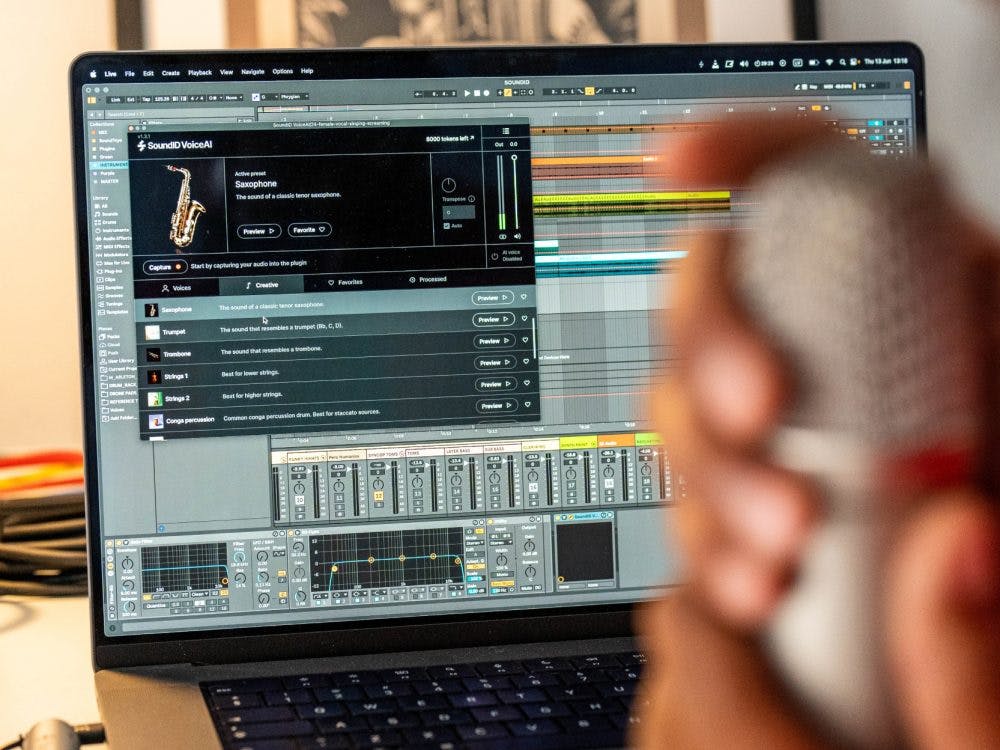AI can generate a remarkable range of instruments from vocal input, including strings like violins and guitars, brass instruments such as trumpets and saxophones, woodwinds like flutes and clarinets, percussion elements including drums and cymbals, and synthesised sounds. This technology uses machine learning algorithms to analyse vocal characteristics and convert them into authentic instrument sounds through advanced audio synthesis techniques.
Understanding AI vocal-to-instrument technology
AI vocal-to-instrument technology represents a significant breakthrough in AI music production tools. This innovative approach allows musicians to transform their voice into virtually any instrument sound using sophisticated machine learning algorithms.
The technology works by analysing the pitch, timbre, and dynamics of your vocal input, then mapping these characteristics onto digital instrument models. What makes this particularly exciting is how it democratises music creation, allowing anyone with a voice to create full instrumental arrangements.
Modern voice-to-instrument AI has gained tremendous popularity because it eliminates traditional barriers in music production. You no longer need expensive instruments or years of training to create professional-sounding tracks. Simply hum a melody or beatbox a rhythm, and the AI transforms it into studio-quality instrumental sounds.
What instruments can AI create from your voice?
The range of instruments that AI can generate from vocal input is surprisingly comprehensive. Voice-to-instrument software can recreate virtually any sound you can imagine, from traditional acoustic instruments to modern electronic sounds.
String instruments form a major category, with AI capable of generating violin, guitar, cello, and piano sounds that respond naturally to your vocal nuances. The technology captures the subtle pitch bends and vibrato in your voice, translating them into authentic string articulations.
Brass and woodwind instruments present another exciting possibility. Your voice can become a trumpet, saxophone, flute, or clarinet, with the AI maintaining the natural breath-like qualities that make these instruments so expressive. The technology even accounts for the attack and decay characteristics unique to each instrument family.
Percussion instruments offer perhaps the most creative potential. Beatboxing translates beautifully into drum kits, with different vocal sounds mapping to kicks, snares, hi-hats, and cymbals. You can create entire rhythm sections using nothing but your voice.
How does voice-to-instrument AI actually work?
The process behind voice-to-instrument conversion involves several sophisticated AI techniques working together. The system first analyses your vocal input using advanced audio analysis, breaking down elements like fundamental frequency, harmonics, and temporal characteristics.
Machine learning models trained on thousands of instrument recordings then match your vocal patterns to corresponding instrument behaviours. These models understand how a violin bow creates different textures or how a trumpet’s valve combinations affect pitch and timbre.
The final step involves synthesis, where the AI generates the instrument sound based on your vocal input. This isn’t simple pitch-shifting, it’s intelligent reconstruction that maintains musical expression whilst creating authentic instrument tones.
The most advanced systems use neural networks that can process audio in segments as short as one second, allowing for responsive performance that feels natural and intuitive. This technology continues improving as more vocal and instrument data trains the underlying models.
Which AI tools are best for vocal instrument generation?
Several platforms now offer voice-to-instrument capabilities, each with distinct strengths and target audiences. Professional-grade plugins integrate directly into digital audio workstations, allowing seamless workflow integration for serious producers.
Some tools focus on studio-quality results with extensive instrument libraries featuring 50 or more voice and instrument presets. These typically offer both local processing for unlimited use and cloud-based processing for users with limited computer resources.
Web-based platforms provide accessibility for casual users, though they may have limitations in terms of audio quality or processing time. Mobile apps cater to on-the-go creativity, perfect for capturing ideas quickly.
When choosing a tool, consider factors like your DAW compatibility, whether you need offline processing, and the specific instruments you want to create. Professional tools often support VST3, AU, and AAX formats across major DAWs like Logic Pro, Pro Tools, and Ableton Live.
What are the creative possibilities with vocal AI instruments?
The creative applications for vocal AI instruments extend far beyond simple instrument replacement. Music producers use this technology to rapidly prototype ideas, creating full arrangements from vocal sketches in minutes rather than hours.
Demo creation becomes incredibly efficient when you can sing all parts of a song and have them converted to realistic instruments. This approach allows for quick iteration and experimentation without needing access to multiple instruments or musicians.
Live performance opens up exciting possibilities, with artists using voice-to-instrument AI to become one-person orchestras. The technology responds to vocal dynamics and expression, making performances feel organic rather than mechanical.
Sound design and experimental music benefit enormously from this technology. You can create unique textures by processing unusual vocal sounds through instrument models, generating sounds that wouldn’t be possible with traditional instruments alone.
Making the most of AI vocal instrument technology
Voice-to-instrument AI represents a fundamental shift in how we approach music creation. The technology removes traditional barriers whilst maintaining the human element that makes music emotionally resonant.
To get started effectively, focus on clear vocal input and experiment with different vocal techniques to discover which translate best to your desired instruments. Practice humming melodies and beatboxing rhythms to develop your voice as a versatile musical instrument.
The future of this technology looks incredibly promising, with continuous improvements in audio quality and instrument variety. As AI models become more sophisticated, we can expect even more realistic and expressive instrument generation.
We at Sonarworks continue pushing the boundaries of what’s possible with AI-driven audio technology. Our SoundID VoiceAI represents years of research into making professional-quality vocal processing accessible to creators at every level, helping bridge the gap between musical ideas and polished productions.
If you’re ready to get started, check out VoiceAI today.



